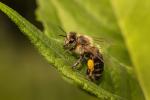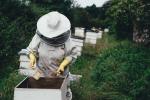
H2020 IoBee Project: IoT Application for Hive Health to Combat Bee Colony Mortality
- Type Project
- Status Filled
- Execution 2017 -2020
- Assigned Budget 1.436.178,00 €
- Scope Europeo
- Main source of financing Horizon 2020
- Project website IoBee
The Irideon coordinator ensured smooth and timely communication with the Project Officer. Irideon ensured that all milestones were met and that all reports were delivered as per the contract. Irideon also oversaw the financial administration of the project, collecting, reviewing, managing, distributing, and submitting information.
In terms of intellectual property and knowledge management, all partners were actively involved. Irideon, Canetis, and Avi-Gis, with support from HMU and Bee Life, worked to identify relevant and potentially new intellectual property and the full commercial potential it offered.
The project website was continuously updated, and various dissemination and communication materials were produced: brochures, banners, leaflets, etc.
Canetis, with the support of its industrial partners, developed a Business Innovation Plan based on the findings from its commercial and customer development plans.
All partners again participated in outreach and communication activities throughout Europe and the US. The SME partners continued to focus their efforts on international industry events. The HMU partner continued to focus its efforts on the scientific community. Bee Life promoted the project to a variety of audiences.
Canetis, HMU, and Irideon designed and produced the TRL8 prototypes, which were validated through pilot tests with end-users. The prototypes were successfully validated by the partners in pilot tests conducted in Spain, Belgium, France, Italy, Romania, and the USA.
IoBee technology has reached TRL9, a strong market presence has been established, and industrial partners have received their first orders from interested customers. The time to market has been reduced to just two months following project completion.
For the past 25 years, European beekeepers have reported declining bee numbers and colony losses, and the situation is worsening. The IoBee consortium seeks to commercialize a new IoT sensor application that can automatically assess colony health and threat status, becoming the technical framework for an interoperable and open European Bee Health Monitoring Network.
The system will wirelessly transmit health and threat results to a cloud server, allowing access to the data to run prediction models and risk assessments, issue alerts, and perform historical analysis.
As a result, colonies in poor condition or under threat will be detected remotely with greater time and precision, saving millions of euros in potential losses.
The general objectives of the project are:
- Advanced design and testing of optoelectronic sensors
- Advanced WSN Prototyping - Wireless Sensor Network (Nodes and Gateway)
- Development of a cloud-based application for beehive monitoring, supported by a Spatial Decision Support System (SDSS)
- Integration and field testing and piloting of the IoBee prototype system
- Delivering IoBee to the market and society
Over the past 15 years, European beekeepers have reported declining bee numbers and colony losses. The situation is worsening, as, according to a recent study by the European Union Reference Laboratory for Bee Health, some countries are losing up to a third of their colonies each year.
Honeybees are essential for the pollination of many agricultural crops, and concerns have arisen about the ability to maintain the pollination services needed to ensure pollinator-dependent food production. Today, European citizens consider the decline in bee numbers to be the most serious environmental problem, even more so than climate change.
The IoBee consortium aims to revolutionize the beekeeping market by reducing colony losses by at least 50%! Through this project, we aim to test and commercialize a new Internet of Things (IoT) sensor application that can automatically assess a colony's threat status.
The system will wirelessly transmit results to a cloud server, making field data available for running prediction models, conducting risk assessments, issuing warnings, and performing historical analysis using a spatial decision support system (SDSS). This will allow beekeepers to be active participants in colony monitoring programs with unprecedented accuracy and responsiveness. As a result, unhealthy or threatened colonies will be remotely detected earlier and with greater accuracy, saving millions of euros in potential losses.
Many systems for monitoring beehives already exist on the market. However, there are three main gaps in the SoA: 1) No solution can i) fingerprint individual bees and determine if they are healthy or have a problem (disease, poisoning, etc.), ii) identify bee castes, and iii) identify insect pests that attack hives. 2) No solution offers IoT capabilities or follows standards that would allow for the first interoperable surveillance network in Europe. 3) No solution has an SDSS, which is fundamental for an advanced EU surveillance system.
In terms of progress beyond the state of the art, IoBee's advantages/selling points are:
- Data is collected automatically, non-invasively, and sent wirelessly to a cloud server.
- The spread of invasive species is automatically assessed, avoiding problems with traps.
- System designed to automatically and remotely evaluate the health status of the hive.
- The insects are automatically counted in the hive's optical module.
- Species identification is performed automatically in the bioacoustic module.
- SDSS acquires accurate field information daily.
- The entire system provides private and public entities with a single, interoperable, and efficient computerized management structure for hive health data.
The main exploitable results of IoBee:
1. The node and gateway units
2. The bioacoustic species identification system
3. The web software application
4. The SDSS
Expected potential impacts:
Economic
- Reduction in the costs of manual hive inspection;
- Reduction of veterinary care costs for colonies and beekeepers;
- Reduction of pesticide/antibiotic use in hive IPM;
- Reduction or elimination of costs to replace lost bees or completely collapsed colonies;
- Prevent the disruption of agricultural products whose pollination depends on bees.
European
- Help fill a knowledge gap in EFSA and EURLab policies;
- Contribution to improve sustainable prevention of hive collapse;
- Contribution to efficiently combat the dangerous mortality of bees;
- Addresses the priorities of the EC Eco-innovation Action Plan;
- Addresses the priorities of the Environmental Action Programme until 2020;
- Addresses the priorities of the Europe 2020 Flagship Initiatives;
- Addresses the priorities of the EU Animal Health Strategy;
- Addresses the priorities of the EU Biodiversity Strategy 2020
Social
- Protect the beekeeping sector and pollination;
- Reduce the disease/pest burden of bees;
- Help expand business opportunities for SMEs and support employment;
- Creation of new IPM services for the beekeeping sector,
Regulations and Standards - Improve the implementation of an EFSA and EURLab network for monitoring and controlling beehives;
- Sustainable use of medical devices, complying with the new EU REACH and MRL regulations;
- Facilitate the implementation of the Requirements for the protection of bee health in the EU (92/65/EEC);
- Facilitate the implementation of the Protection of bee health against exotic diseases (EU No 206/2010);
- Facilitate the implementation of support measures for the beekeeping sector (EC No. 1234/2007)
Scientific and technological advances
- Improve bioacoustic knowledge of A. mellifera; Better understand the dynamics and infestations of bees and their pests;
- Consolidate transnational knowledge on European regions affected by high bee mortality;
- Identify specific issues related to the use of technology, best practices, and the development of IPM procedures.
Environment/Health
- Sustainable use of medical devices; Preventing the increasing number of bee disease and pest outbreaks;
- Support the work of the Agriculture and Food Safety Agencies;
- Contribute to sustainable organic beekeeping;
- Help protect A. mellifera, an endangered species.
- IRIDEON SL (IRIDEON S.L.)







